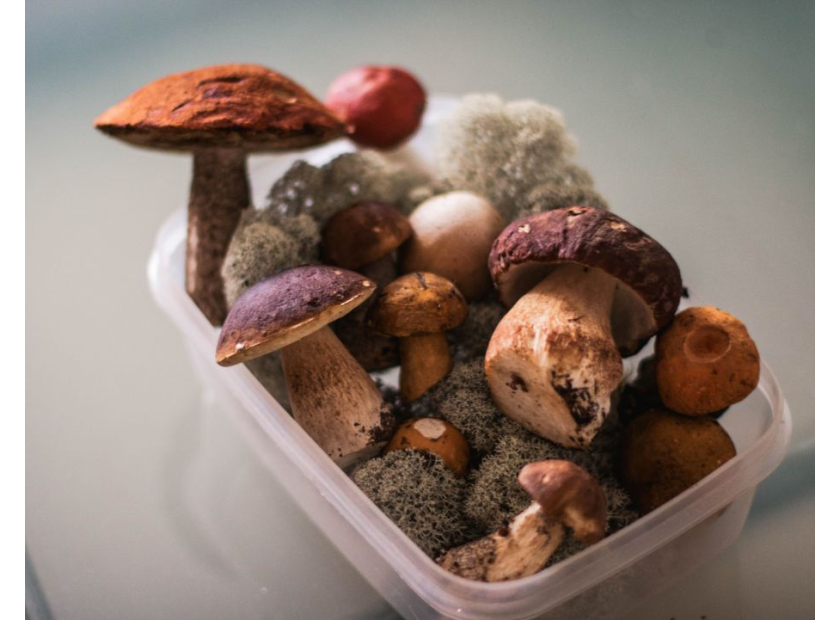What’s all the hyphae about?: Sustainable fungi-based plastic alternatives
Plastic is invaluable to the scientific community from Petri plates to syringes and almost everything in between. Scientific research alone accounts for approximately 1.8% of global plastic production.(1) With the COVID-19 pandemic the need of the scientific community is increasing due to the increased need for plastic used for PPE, plastic tubes, pipets, etc.(2) While plastic use is vital for many applications, about 91% of all plastic isn’t recycled.(3) It is cheaper and faster to make more plastic than to use recycled materials. With the added hazards associated with plastics used in various scientific and medical applications, recycling plastic in the sciences is more challenging, expensive, and therefore more limited.(4)
While alternatives to plastic cups and cutlery are increasingly available, replacing single-use items in a laboratory or healthcare setting is more challenging. One plastic alternative comes from the lab in the form of filamentous fungi.
Fungi, more specifically their hyphae, can provide an alternative to reduce overall plastic consumption while also reducing energy usage and carbon dioxide production associated with plastic production.(5)
A fungi-based plastic alternative “foam” is created by first inoculating a matrix of agricultural wastes with fungal spores. These spores germinate and are allowed to grow at the optimal conditions for the specific organism. The mycelial network develops within a shaped form that “molds” the fungi into a specific shape. The form also prevents the development of a fruiting body which allows for the formation of more mycelia.

In the future, living fungi could even become our wearable technology and reduce e-waste in addition to plastics.

It has the added advantage of offering color without adding dyes.
The process is somewhat similar to using injection and similar molds with inorganic materials. This fungal growth takes about a week to complete.(6, 7) After the mycelia have taken shape, the fungi mixture is heated and dried to stop the growth by killing the fungi.(8) The resulting foam is fairly inexpensive and hardy like plastics but biodegradable in soil within 45 days.
Thermal insulation and water resistance make this material ideal for packaging. The foam-like properties can help absorb impact and different forms can be customized to fit a variety of products, cutting down on the need for plastic-based options.

The applications don’t end there as mycelia building materials, insulation, “un-leather,”
meat alternatives, soundproofing, and more are already on the market(10). Even Adidas has incorporated mushroom-based materials into a line of shoes.(8, 9)

For instance, it takes 2,500 liters of water, fertilizer, and pesticides to create one cotton T shirt. A fungal alternative takes only 12 liters of water.

While fungi foam can’t currently take the place of many of the plastics used in the sciences, the technology is still fairly new and new applications could replace more single use plastics.
For now, reducing our plastic consumption and replacing it with renewable and sustainable fungi can make a big difference to our environment.
Works Cited:
- https://www.sciencedaily.com/releases/2015/12/151223221353.htm
- https://www.ncbi.nlm.nih.gov/pmc/articles/PMC7726519/
- https://www.epa.gov/facts-and-figures-about-materials-waste-and-recycling/plastics-material-specific-data
- https://reader.elsevier.com/reader/sd/pii/S2542504821000348?token=D215208256797DD49B27110A579F5DD0D6545272A15C94FE0BB67CADA92CA3D3DD69F861FC4EC75543B18AF53CE18942&originRegion=us-east-1&originCreation=20211029223809
- https://www.researchgate.net/publication/336146038_Mushroom_Packages_An_Ecovative_Approach_in_Packaging_Industry
- https://blogs.scientificamerican.com/observations/the-mycelium-revolution-is-upon-us/
- https://matmatch.com/resources/blog/mycelium-using-mushrooms-to-make-packaging-materials/#:~:text=There%20are%20also%20many%20applicable,textiles%2C%20clothing%2C%20and%20shoes.
- https://undecidedmf.com/episodes/is-fungus-the-plastic-of-the-future
- https://www.adidas.com/us/blog/663481-stan-smith-mylotm-made-using-mushrooms
- https://insights.globalspec.com/article/14950/fungi-based-leather-could-be-the-most-sustainable-leather-option

Meet the author

PERFORMANCE STUDIES SUPERVISOR at HARDY DIAGNOSTICS
Lauren Hamilton, MS Microbiology & Cell Science
Lauren leads a team dedicated to achieving FDA 510(k) clearance for Class II microbiology in vitro diagnostics devices, AOAC certifications, MicroVal certifications, and more. She earned her BS in Microbiology from Cal Poly San Luis Obispo while conducting epigenetics research and her MS in Microbiology and Cell Science at the University of Florida. An active member of the American Society for Microbiology (ASM), AOAC International, and the International Association for Food Protection (IAFP), Lauren contributes to these organizations through publications, presentations, and committee service. She serves on the AOAC INTERNATIONAL Safety and Security Committee. Additionally, Lauren leads the Hardy Diagnostics Community Action Committee, coordinating the company’s community involvement. In her free time, Lauren enjoys practicing aerial arts, experimenting with new recipes, and volunteering in the community.







